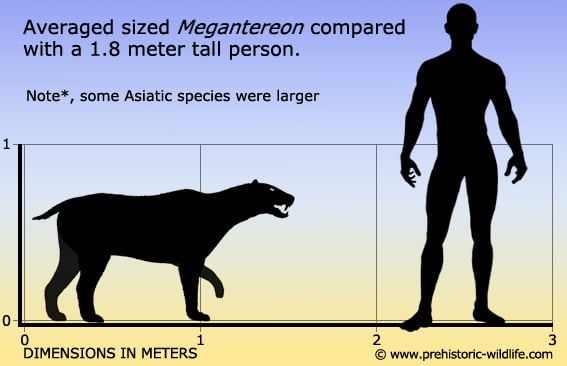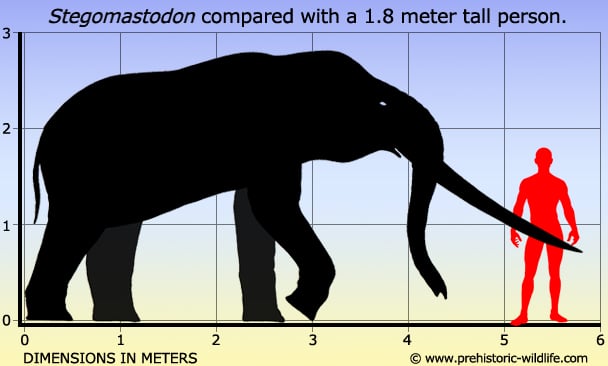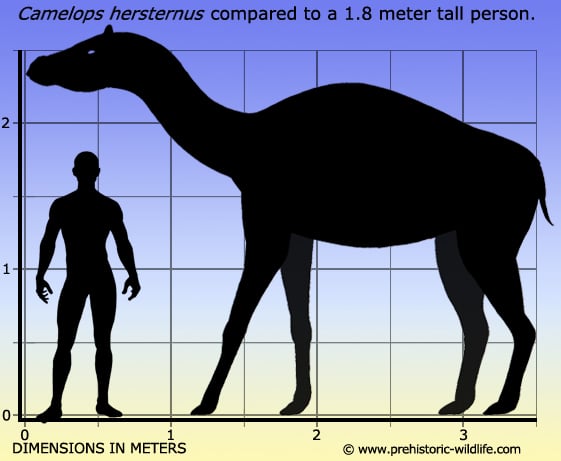|
|
Post by Talira Greycrest on Sept 12, 2021 9:53:31 GMT
Is that anvil-like antler used for fighting over females? I would assume it was probably for display. |
|
|
|
Post by Talira Greycrest on Sept 12, 2021 10:28:43 GMT
Name: MegantereonPronunciation: Meg-an-ter-e-onMeaning of name: "Giant beast"Species: M. cultridens, M. adroveri, M. ekidoit, M. falconeri, M. hesperus, M. microta, M. vakshensis, M. whiteiSize: Uncertain, as many known specimens are fragmentary. Average length is estimated to have been around 1.5 metresFamily: FelidaeDiet: CarnivoreFirst fossils found: Known only from partial and fragmentary specimens discovered in Africa, Eurasia and the United States. M. cultridens named by Georges Cuvier in 1824. M. falconeri named in 1853. M. hesperus named in 1933. M. whitei named in 1937. M. vakshensis named in 1986. M. adroveri named in 1987. M. ekidoit named in 2000. M. microta named in 2015.Lived: Depending on species, lived between 4.5 and 2 million years ago from the Zanclean stage of the Early Pliocene through to the Gelasian stage of the Early Pleistocene.
|
|
Tix Mascot
Tech guru
Italy is my second homeland
Posts: 11,097  Mini-Profile Background: {"image":"http://4.bp.blogspot.com/-X5mhw13BJ7Y/TwKeZ3uM7YI/AAAAAAAABPw/D82go4Ny_8E/s1600/italy-background-8-787281.jpg","color":""}
Mini-Profile Text Color: 0ef8f1
Mini-Profile Name Color: f40d39
Year of Birth: 1961
Nationality: Norwegian
Mini-Profile Background: {"image":"http://4.bp.blogspot.com/-X5mhw13BJ7Y/TwKeZ3uM7YI/AAAAAAAABPw/D82go4Ny_8E/s1600/italy-background-8-787281.jpg","color":""}
Mini-Profile Text Color: 0ef8f1
Mini-Profile Name Color: f40d39
Year of Birth: 1961
Nationality: Norwegian
|
Post by Tix Mascot on Sept 12, 2021 13:06:08 GMT
Not what I would want chasing me...
|
|
|
|
Post by Talira Greycrest on Sept 13, 2021 10:44:36 GMT
Name: StegomastodonPronunciation: Steg-o-mas-toe-donMeaning of name: "Roof breast tooth"Species: S. aftoniae, S. mirificus, S. nebrascensis, S. primitivusSize: Depending on species, measured up to 6 metres long (including tusks), 2.5 metres tall and weighing between 4 and 5 metric tonnes.Family: GomphotheriidaeDiet: HerbivoreFirst fossils found: Known from several specimens discovered throughout the United States. S. mirificus named by American palaeontologist, Joseph Mellick Leidy, in 1858. S. nebrascensis and S. aftoniae named in 1924. S. primitivus named in 1936.Lived: Depending on species, lived between 4 and 1.2 million years ago from the Zanclean stage of the Early Pliocene through to the Calabrian stage of the Middle Pleistocene in what is now the midwestern, pacific northwest, southwestern, south-central and western United States.
|
|
Tix Mascot
Tech guru
Italy is my second homeland
Posts: 11,097  Mini-Profile Background: {"image":"http://4.bp.blogspot.com/-X5mhw13BJ7Y/TwKeZ3uM7YI/AAAAAAAABPw/D82go4Ny_8E/s1600/italy-background-8-787281.jpg","color":""}
Mini-Profile Text Color: 0ef8f1
Mini-Profile Name Color: f40d39
Year of Birth: 1961
Nationality: Norwegian
Mini-Profile Background: {"image":"http://4.bp.blogspot.com/-X5mhw13BJ7Y/TwKeZ3uM7YI/AAAAAAAABPw/D82go4Ny_8E/s1600/italy-background-8-787281.jpg","color":""}
Mini-Profile Text Color: 0ef8f1
Mini-Profile Name Color: f40d39
Year of Birth: 1961
Nationality: Norwegian
|
Post by Tix Mascot on Sept 13, 2021 12:22:43 GMT
Any significant difference to a traditional mastodon?
|
|
|
|
Post by Joey12 on Sept 14, 2021 1:30:37 GMT
Could be, it's interesting to see deer fight but it's mostly playing here and then they go back to eating.
|
|
|
|
Post by Talira Greycrest on Sept 14, 2021 9:43:12 GMT
Any significant difference to a traditional mastodon? No, I don't think there is, but I know there's definitely a difference between mammoths and mastodons. First of all, mammoths were bigger and had fatty lumps on their backs which provided them with additional nutrients that was necessary in their ice-covered habitats. Mastodons also had cone-shaped cusps on their molars designed to crush leaves, twigs and branches. |
|
|
|
Post by Talira Greycrest on Sept 15, 2021 10:41:01 GMT
Name: CamelopsPronunciation: Cam-el-opsMeaning of name: "Camel face"Species: C. kansanus, C. minidokae, C. hesternusSize: Depending on species, measured up to 3.5 metres long, 3 metres tall and weighing up to 800kgsFamily: CamelidaeDiet: HerbivoreFirst fossils found: Known from several specimens discovered throughout the western United States. C. kansanus named by American palaeontologist, Joseph Mellick Leidy in 1854. C. hesternus named in 1873. C. minidokae named in 1927.Lived: Depending on species, lived between 4 million years and 10,000 years ago from the Zanclean stage of the Early Pliocene through to the Greenlandian stage of the Holocene era throughout what is now the western United States.
|
|
Tix Mascot
Tech guru
Italy is my second homeland
Posts: 11,097  Mini-Profile Background: {"image":"http://4.bp.blogspot.com/-X5mhw13BJ7Y/TwKeZ3uM7YI/AAAAAAAABPw/D82go4Ny_8E/s1600/italy-background-8-787281.jpg","color":""}
Mini-Profile Text Color: 0ef8f1
Mini-Profile Name Color: f40d39
Year of Birth: 1961
Nationality: Norwegian
Mini-Profile Background: {"image":"http://4.bp.blogspot.com/-X5mhw13BJ7Y/TwKeZ3uM7YI/AAAAAAAABPw/D82go4Ny_8E/s1600/italy-background-8-787281.jpg","color":""}
Mini-Profile Text Color: 0ef8f1
Mini-Profile Name Color: f40d39
Year of Birth: 1961
Nationality: Norwegian
|
Post by Tix Mascot on Sept 15, 2021 12:10:39 GMT
Not too different looking from today's camels.
|
|
|
|
Post by Talira Greycrest on Sept 16, 2021 13:45:50 GMT
Name: MicroleoPronunciation: My-kro-le-ohMeaning of name: "Small lion"Species: M. attenboroughiSize: Uncertain due to a lack of fossils.Family: ThylacoleonidaeDiet: Uncertain. Possible carnivore/insectivoreFirst fossils found: Known only from some teeth, two pieces of jaw and a broken palatine bone discovered in the Riversleigh fossil site of north-west Queensland, Australia. Named by Anna K. Gillispie, Michael Archer and Suzanne J. Hand in 2016.Lived: 18 million years ago during the Burdigalian stage of the Early Miocene in what is now north-west Queensland, Australia. Artist's impression of Microleo Artist's impression of Microleo
|
|
|
|
Post by Joey12 on Sept 16, 2021 23:43:48 GMT
Teeth and pieces, I'm guess ing they are making a wild guess. But I don't see a picture.
|
|
|
|
Post by Talira Greycrest on Sept 17, 2021 1:52:32 GMT
 Can you see this pic? |
|
Tix Mascot
Tech guru
Italy is my second homeland
Posts: 11,097  Mini-Profile Background: {"image":"http://4.bp.blogspot.com/-X5mhw13BJ7Y/TwKeZ3uM7YI/AAAAAAAABPw/D82go4Ny_8E/s1600/italy-background-8-787281.jpg","color":""}
Mini-Profile Text Color: 0ef8f1
Mini-Profile Name Color: f40d39
Year of Birth: 1961
Nationality: Norwegian
Mini-Profile Background: {"image":"http://4.bp.blogspot.com/-X5mhw13BJ7Y/TwKeZ3uM7YI/AAAAAAAABPw/D82go4Ny_8E/s1600/italy-background-8-787281.jpg","color":""}
Mini-Profile Text Color: 0ef8f1
Mini-Profile Name Color: f40d39
Year of Birth: 1961
Nationality: Norwegian
|
Post by Tix Mascot on Sept 17, 2021 11:33:00 GMT
I see it now.  |
|
|
|
Post by Talira Greycrest on Sept 17, 2021 13:30:36 GMT
Name: SamburupithecusPronunciation: Sam-bu-ru-pith-e-kusMeaning of name: "Samburu ape"Species: S. kiptalamiSize: Uncertain due to a lack of fossils.Family: HominidaeDiet: HerbivoreFirst fossils found: Known only from teeth and jaws discovered by a joint Japan-Kenya Expedition at the SH22 fossil site in the Samburu District of Rift Valley Province, Kenya, eastern Africa. Named by Hidemi Ishida and Martin Pickford in 1997.Lived: 14 to 7 million years ago from the Langhian stage of the Middle Miocene through to the Messinian stage of the Late Miocene in what is now Kenya, eastern Africa.

Samburupithecus jaw fragment
|
|
|
|
Post by Joey12 on Sept 18, 2021 3:24:42 GMT
Bet those teeth could do some grinding.
|
|